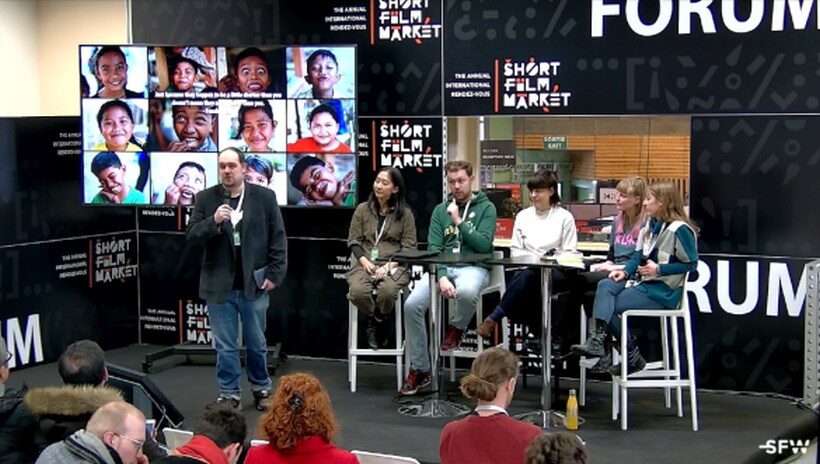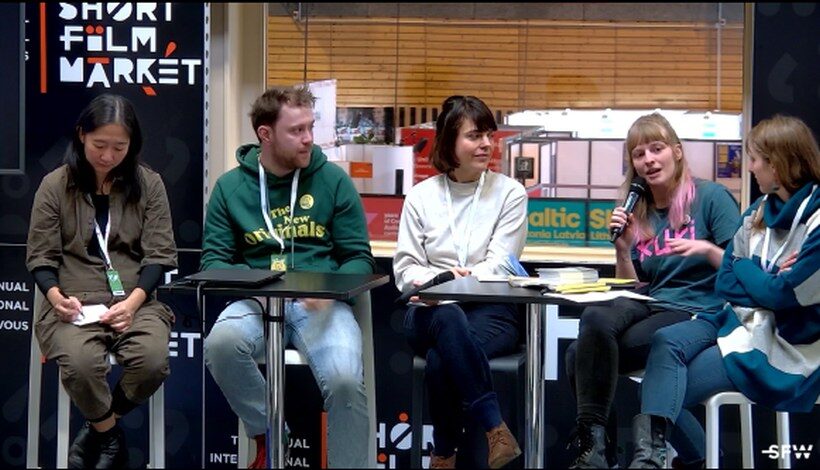
FLTR Laurence Boyce (Short Film Conference), Fransiska Prihadi (Minikino Film Week), Hidde de Vries (CineKid Festival), Lina Paulsen (Mo&Friese Junges Kurzfilm Festival Hamburg), Fredi Klutas (KUKI Young Short Film Festival), Manon Guérin (Plein la Bobine) © Short Film Conference
The Short Film Conference’s recent event sought to examine not only how we bring audiences to short films, but why it is crucial to do so. With a large number of film festivals (both short and features) dedicated solely to children’s and youth films, the market for films aimed at those aged between two and 18 is both popular and expansive. While the very notion of a ‘children’s film’ is aesthetically somewhat nebulous – with a myriad of ways in which a film can resonate with people of a young age – they represent an integral and important part of the short and feature film world.
However their importance goes beyond their content. Films and festivals aimed at young people all fill a role in one of the crucial questions that those involved in the theatrical screening of cinema continually ask themselves: how are we going to entice a new generation of audiences into screening rooms across the world? While this question has existed since the invention of cinema, the large changes in media consumption over past decade – both in terms of technology and the recent pandemic – have made it seem more pertinent that ever before.
An event organised by the Short Film Conference, held at the most recent edition of the Clermont-Ferrand International Short Film Festival, entitled ‘Young People and Short Film Audiences’ was ostensibly a chance for a number of film festivals, all specialising in children’s films, to discuss how they engaged youth audiences and sought to bring a new generation into the cinema.
At the event, the people on hand to discuss their festivals were moderator Lina Paulsen from Mo&Friese Junges Kurzfilm Festival Hamburg, the long running children’s counterpart to the International Short Film Festival Hamburg. She was joined by Fredi Klutas, from KUKI Young Short Film Festival, itself a counterpart to the annual interfilm Berlin Short Film Festival and Manon Guérin from Plein la Bobine based in France. The panel was rounded out by Fransiska Prihadi from Minikino Film Week in Indonesia and Hidde de Vries from CineKid Festival in The Netherlands, both festivals which showcase both feature and short films.
One common thread throughout the festivals was the importance of making the entire experience of cinema going ‘an experience’. Whilst many festivals could guarantee healthily attended school screenings, by virtue of having entire classloads of children taken directly to the cinemas, proper engagement of child and teen audiences was achieved by providing workshops, youth juries and the chance to be involved in issues such as programming.
This approach goes someway to dealing with two important aspects of encouraging new audiences. Firstly, as those who know the infamous Steve Buschemi meme “How do you do fellow kids,” are acutely aware, trying to programme films for young people without input from said young people runs the risk of talking down to potential young audiences and programming works of which they have no connection. Social media strategies were also talked about in much the same way: the best way to know how to an engage a youth audience via a social media presence is to ask young people directly the social media you should be using.
The other key aspect is emphasising the special nature of a festival, the joy of being together in both its creation and the ultimate screening of works. Watching content is now an ubiquitous part of life, as is the short form. The context in which it is consumed is now key to engagement. As mainstream cinema continually touts 3D and the ‘Blockbuster Experience’ to entice people to come to theatres, the festival world is also differentiating itself from the act of watching films on a small screen.

FLTR Fransiska Prihadi (Minikino Film Week), Hidde de Vries (CineKid Festival), Lina Paulsen (Mo&Friese Junges Kurzfilm Festival Hamburg), Fredi Klutas (KUKI Young Short Film Festival), Manon Guérin (Plein la Bobine) © Short Film Conference
Outside of the event, Cinekid’s Hidde de Vries expanded on the situation:
“We experience that providing an experience that is focused on more than film really attracts bigger audiences as audiences expect more from live film-events. Watching films without ‘context’ is something that people do more and more at home. Therefore we host interactive quizzes, meet-and-greets, Q&A’s and festive premiere events to make it more than ‘just visiting the cinema’. We see that this contributes to the festival ambiance of experiencing and discovering films.”
It is interesting as to whether the short form holds a particular interest for young audiences. More than a decade ago, the short form was something of an outlier, with mainstream cultural consumption being either the feature film or TV. But with the rise of YouTube and TikTok, short (often ultra-short) content is the norm for a young generation as opposed to the exception.
I wondered whether this shift in culture was having an effect on how young audiences approach short films, and whether it was different from maybe in the past. Posing this question outside of the event to Fransiska from Minkino, she said:
“The topic is an interest for one of my colleagues at Minikino, Made Birus, the travelling festival director with the main task of going to villages in Bali for year-round education engagement & pop-up cinema during Minikino Film Week.
Ever since the popularity of YouTube, he had noticed rising interest in becoming ‘the maker’ of the content of this new media. However, TikTok is the catalyst because it’s so easy to use. Young audiences feel that they can and want to be a maker and both the audience & consumer.
He noticed that there is no literacy about the short film itself: the comprehension is merely content to be put up on their YouTube or Social Media account. Mostly young audiences are just copying a popular trend: there is almost zero awareness that the short film medium could give voice to their story.”
Hidde De Vries gave an insight into his perspective of a European audience:
“We see an increase in visits for our short film programs, but features are still the most visited programs. We also see that young audiences love the dynamics of a short film programme at for instance educational screenings. They’re really used to short forms.”
He also noted a slight generation gap in how people perceived shorts:
“Parents however still experience ‘shorts’ as something that can be found online for free. They rather choose for something they think is ‘worth the money’. We also see a preference for short films in educational settings. Teachers love short films as they’re easier to use in the timeframe of just one lesson.”.
Another key element to the discussion is whether these young audiences continue into adulthood. Those from KUKI and Mo&Friese, two festivals which run parallel to adult orientated festivals, made anecdotal observations about audience members who had crossed over from the youth sections and were now attending the festival as adults. Indeed, beyond audiences, examples were made of those who had found their way into the film industry. Klutas shared a story of one former attendee of the youth workshops who was now doing various things for the adult version of the festival. De Vries made mention of Milou Gevers who, as a youngster, attending Cinekid. In 2021 she was collecting a Student Academy Award for her short documentary WHY DIDN’T YOU STAY FOR ME?
The short film has always been progressive, but even the most dynamic of mediums need to prevent the structures around them becoming stale and ossified. The search to connect young audiences with shorts in not only to get them to experience a myriad of amazing work but also to keep the medium, and the industry that surrounds it, relevant for today and ready to face the challenges of the future.
The event Young People and Short Film Audiences can be viewed at https://www.shortfilmconference.com/events/
Laurence Boyce is Chairman of the Board of the Short Film Conference, an international organization seeking to unite the global short film community